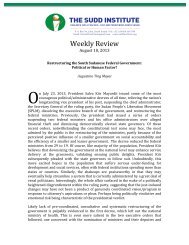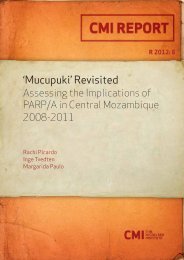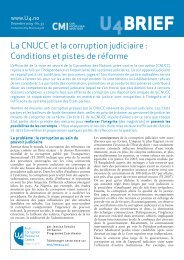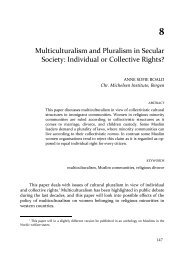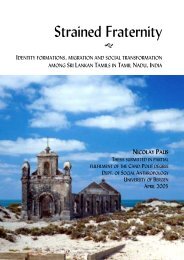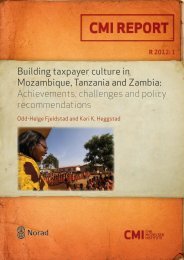Peacebuilding: Lessons for Afghanistan? - CMI
Peacebuilding: Lessons for Afghanistan? - CMI
Peacebuilding: Lessons for Afghanistan? - CMI
Create successful ePaper yourself
Turn your PDF publications into a flip-book with our unique Google optimized e-Paper software.
SRSG undertook a lone, one-man per<strong>for</strong>mance. While Pakistan also actively engaged<br />
in the negotiations, Islamabad had strong partisan interests and gave massive support<br />
to its own client faction. A transition agreement brokered in Pakistan in mid-1992<br />
provided <strong>for</strong> an elected government in 18 months, but lacked mechanisms <strong>for</strong> settling<br />
disputes between the parties and provisions <strong>for</strong> asserting state control of the<br />
commanders and regionally based armies. The domination of the new cabinet by one<br />
party, the Jamiat-e Islami, alienated other groups, which boycotted the next transition<br />
phase. The peace process was effectively dead.<br />
By mid-1995 the situation on the ground changed dramatically as the new Taliban<br />
movement gained control over most of southern and western <strong>Afghanistan</strong>, and in 1996<br />
captured Kabul. At the UN, Lakhdar Brahimi took over as SRSG in late July 1997 and<br />
tried to confront the destructive logic of competitive <strong>for</strong>eign interference by calling<br />
the relevant states into a joint <strong>for</strong>um - the so-called 6+2 group (neighbouring states<br />
plus USA and Russia). 11 An expanded UN peace mission (UNSMA) brought Afghans<br />
other than the armed factions into the peace consultations, particularly Afghans in<br />
exile. However, with the Taliban in control of most of the country, and the Northern<br />
Alliance riven by internal tension, neither the Afghan parties nor their regional<br />
backers were ready to engage in serious peace talks. In February 2000, Brahimi<br />
resigned.<br />
As a recent evaluation of UN engagement in <strong>Afghanistan</strong> has pointed out, the<br />
diplomatic side in the coordinated Strategic Framework launched in 1998 worked on<br />
the assumption that only isolation would be effective in relation to the Taliban. The<br />
aid community, by contrast, tended to advocate constructive engagement (see chapter<br />
5 below). 12 The difference in perspective was rein<strong>for</strong>ced by mistrust between the<br />
diplomatic and the aid communities, precluding ef<strong>for</strong>ts to link assistance to peacebuilding<br />
in a constructive manner. Yet, some positive developments were noted,<br />
including UNSMA's recognition of the need to engage Afghan civil society more<br />
broadly in the consultations.<br />
At the same time, a discussion emerged in the aid community of possibilities <strong>for</strong><br />
starting reconstruction as a step towards peace, rather than following the conventional<br />
sequence of peace first, reconstruction second. 13 Innovation was supported at the<br />
highest level in the UN: in August 2001, Kofi Annan called <strong>for</strong> a new approach to<br />
promote peace in <strong>Afghanistan</strong>. 14 As it turned out, the initiative was overtaken by the<br />
events of September 11 and their aftermath.<br />
11 Matthew Fielden & Jonathan Goodhand (2001), "Beyond the Taliban: The Afghan Conflict and<br />
United Nations Peacemaking ", Conflict, Security and Development, vol. 1, no. 3.<br />
12 Mark Duffield, Patricia Gossman and Nick Leader (2001), Review of the Strategic Framework <strong>for</strong><br />
<strong>Afghanistan</strong> (final draft), Islamabad: Strategic Monitoring Unit.<br />
13 Promoting peace-building through reconstruction was a major theme at the Afghan Support Group<br />
meeting of donors and aid organizations held in Islamabad in June 2001. The ideas inspiring the current<br />
initiative <strong>for</strong> a massive reconstruction package to solidify the peace process are in fact closely related to<br />
those underlying the discussions in Islamabad.<br />
14 United Nations General Assembly, Security Council (2001), The Situation in <strong>Afghanistan</strong> and its<br />
Implications <strong>for</strong> International Peace and Security, Report of the Secretary-General, A/55/1028-<br />
S/2001/789. www.un.org/Docs/sc/reports/2001/789e.pdf.<br />
6



